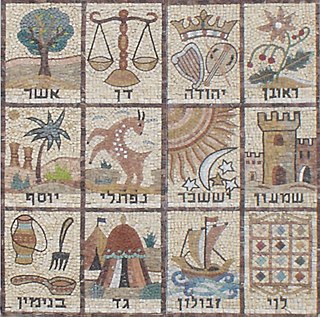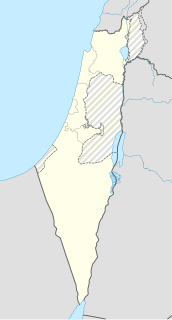
According to the Hebrew Bible, the Kingdom of Israel was one of two successor states to the former United Kingdom of Israel and Judah. Historians often refer to the Kingdom of Israel as the "Northern Kingdom" or as the "Kingdom of Samaria" to differentiate it from the Southern Kingdom of Judah.

The Israelites were a confederation of Iron Age Semitic-speaking tribes of the ancient Near East, who inhabited a part of Canaan during the tribal and monarchic periods. According to the religious narrative of the Hebrew Bible, the Israelites' origin is traced back to the Biblical patriarchs and matriarchs Abraham and his wife Sarah, through their son Isaac and his wife Rebecca, and their son Jacob who was later called Israel, whence they derive their name, with his wives Leah and Rachel and the handmaids Zilpa and Bilhah.

Herod Agrippa II officially named Marcus Julius Agrippa and sometimes shortened to Agrippa, was the eighth and last ruler from the Herodian dynasty. He was the fifth member of this dynasty to bear the title of king, but he reigned over territories outside of Judea only as a Roman client. Agrippa was overthrown by his Jewish subjects in 66 and supported the Roman side in the First Jewish–Roman War.
According to the Hebrew Bible, the Tribe of Reuben was one of the twelve tribes of Israel. Unlike the majority of the tribes, the land of Reuben, along with that of Gad and half of Manasseh, was on the eastern side of the Jordan. According to the biblical narrative, the Tribe of Reuben descended from Reuben, the oldest son of the patriarch Jacob. Reuben, along with nine other tribes, is reckoned by the Bible as part of the northern kingdom of Israel, and disappears from history with the demise of that kingdom in c. 723 BC.

Bashan is a term for the northernmost region of the Transjordan. The Hebrew Bible first mentions it in Numbers 21:33, where Og the king of Bashan came out against the Israelites at the time of their entrance into the Promised Land, but was vanquished in battle. Along with the half of Gilead it was given to the half-tribe of Manasseh. According to the book of Joshua, Golan, one of its cities, became a Levitical city and a city of refuge.
Yohanan, Yochanan and Johanan are various transliterations to the Latin alphabet of the Hebrew male given name יוֹחָנָן, a shortened form of יְהוֹחָנָן, meaning "YHWH is gracious".

Tel Arad is an archaeological tel, or mound, located west of the Dead Sea, about 10 kilometres west of the modern Israeli city of Arad in an area surrounded by mountain ridges which is known as the Arad Plain. The site is divided into a lower city and an upper hill which holds the only ever discovered "House of Yahweh" in the land of Israel. Tel Arad was excavated during 18 seasons by Ruth Amiran and Yohanan Aharoni.

Javan was the fourth son of Noah's son Japheth according to the "Generations of Noah" in the Hebrew Bible. Josephus states the traditional belief that this individual was the ancestor of the Greeks.

Goodman & Gilman's The Pharmacological Basis of Therapeutics, commonly referred to as the Blue Bible or Goodman & Gilman, is a textbook of pharmacology originally authored by Louis S. Goodman and Alfred Gilman. First published in 1941, the book is in its thirteenth edition, and has the reputation of being the "bible of pharmacology". The readership of this book include physicians of all therapeutic and surgical specialties, clinical pharmacologists, clinical research professionals and pharmacists.

Kabzeel is a Hebrew Bible place name. It was the most remote city of Judah; located in southern Judah on the border of Edom (Idumaea). The location is tentatively identified with Khirbet Hora, about 10 km ENE of Beer-sheba. Kabzeel was the birthplace of Benaiah, one of David's chief warriors. Following the Exile, it was resettled under the name Jekabzeel.
The House of YHWH is a phrase found in the Hebrew Bible and on at least one inscription, usually referring to a temple.
Yohanan Aharoni was an Israeli archaeologist and historical geographer, chairman of the Department of Near East Studies and chairman of the Institute of Archaeology at Tel-Aviv University.

Everyman's Encyclopaedia is an encyclopedia published by Joseph Dent from 1913 as part of the Everyman's Library.
Secacah is a town mentioned in the Hebrew Bible/Old Testament as well as in the Dead Sea Scrolls. The town was located in the wilderness of Judah, otherwise known as the Judean Desert, and is identified by some scholars with the archaeological site of Khirbet Qumran.
Bozkath is a town in the Kingdom of Judah mentioned in the Hebrew Bible/Old Testament. The town was located in the lowland hills of Judah, otherwise known as the Shephelah, and its location is unknown.

Ze'ev Safrai is an Israeli Professor in the Department for Israel Studies in Bar Ilan University, as well as an author, lecturer and researcher of Israel in the Second Temple era. His main project is his authorship of the socio-historical commentary to the Mishnah called Mishnat Eretz Yisrael, which he began together with his late father Professor Shmuel Safrai and his late sister Professor Chana Safrai.
Dr. Michael Avi-Yonah was an Israeli archaeologist and historian. During his career he was a Professor of Archaeology at the Hebrew University of Jerusalem, and served as secretary of the Department of Antiquities as well.

Moshe Kochavi was an Israeli archeologist and a founding faculty member of Tel Aviv University's Department of Archaeology and Near Eastern Studies.

The Sebek-khu Stele, also known as the Stele of Khu-sobek, is an inscription in honour of a man named Sebek-khu (Khu-sobek) who lived during the reign of Senusret III discovered by John Garstang in 1901 outside Khu-sobek's tomb at Abydos, Egypt, and now housed in the Manchester Museum.

Ada Aharoni is an Egyptian-born Israeli poet, writer, lecturer, sociologist and peace researcher. Since her first poetry book, Poems from Israel, was launched in 1972 she has published 34 books, including peace poetry, historical novels, sociology and history books, biographies, drama, film-scripts, literary criticism, and books for children. The uprooting of the Jews from Egypt, including herself, following the establishment of Israel in 1948 is one of the main topics in many of her novels. Her research on this "Second Exodus" has been a major focus in her career.













